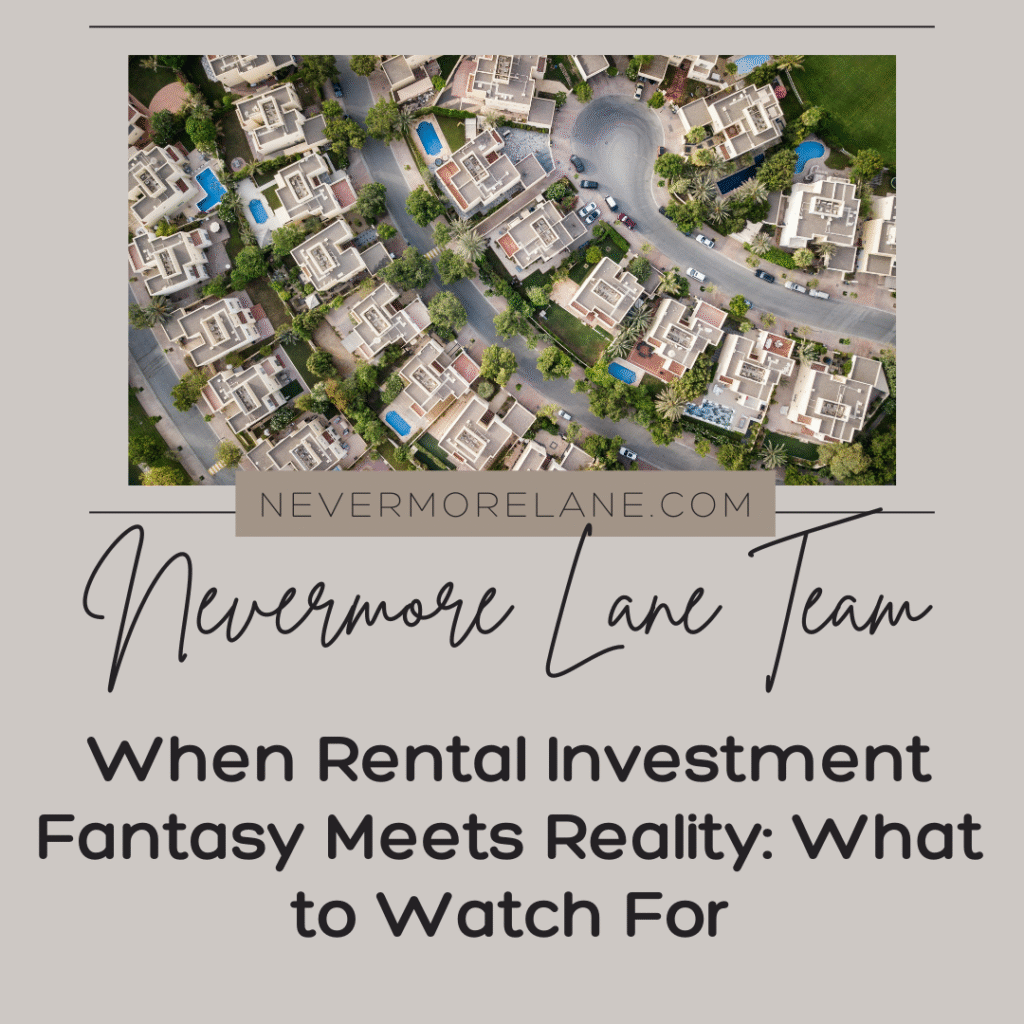When Rental Investment Fantasy Meets Reality: What to Watch For
The excitement of buying a first rental property blinds many new investors to warning signs that experienced landlords spot instantly. The brain goes into this excited, dreamy spiral, maybe they think about buying property in nature, like a cabin in the woods, usually the thoughts of passive income immediately come to mind, getting money for doing nothing, those sorts of ideas (and it doesn’t help social media presses those ideas, too.) But buying a rental isn’t just “buy a house and someone magically pays your mortgage for you”.
The dream of passive income and wealth building through real estate creates tunnel vision that overlooks serious problems lurking beneath fresh paint and staged furniture. First-time investors rush toward closing, convinced they’ve found the perfect property that will generate steady cash flow and appreciate reliably over time. The reality emerges months later when unexpected repairs drain reserves, problem tenants stop paying rent, and the investment becomes a financial nightmare instead of the wealth-building vehicle promised in books and seminars.
Experienced real estate investors develop instincts for recognizing red flags that signal trouble before signing purchase agreements or lease contracts. These warning signs appear consistently across markets, property types, and price ranges, yet first-time investors miss them repeatedly because they lack the pattern recognition that comes only through experience and costly mistakes. Foundation issues disguised by cosmetic updates, neighborhoods experiencing decline despite current stability, tenant screening shortcuts that invite disasters, and financial projections based on wishful thinking rather than realistic expenses all share one thing in common. They seem manageable or insignificant to inexperienced eyes while experienced investors immediately recognize them as deal-breakers.
Learning which rental property red flags matter most protects first-time investors from expensive education through failure. Understanding what separates profitable investments from money pits, recognizing tenant warning signs before signing leases, identifying hidden maintenance costs that destroy cash flow projections, and evaluating neighborhoods for long-term stability rather than current appearance prevents the majority of rookie mistakes. Knowledge replaces expensive experience when new investors learn to see properties and tenants through the critical lens that seasoned landlords apply automatically to every potential investment.
It’s Not Passive Income at the Beginning
Scroll long enough on TikTok, YouTube, or even read a few articles on Forbes, and you’ll see that people love to say “rental income is passive income”. And, yeah, okay, sure, it can be. But in the beginning, it’s a lot. Like, there’s advertising the rental, screening tenants, collecting rent, sorting repairs, chasing payments, being the contact person for everything that goes wrong, and just dealing with stuff that pops up at the most inconvenient time.
And this is the part no one imagines when they’re busy romanticizing rental life on day one. Actually, this is exactly why some people bring in property management once they realise it’s not as hands-off as they expected. But obviously, a service like this isn’t free either, so you have to make the choice whether or not it’s worth the money.
The Area Matters More than Aesthetics
Okay, so one of the first mistakes people make is falling in love with the actual house. But yeah, the area, like the actual neighborhood, matters so much more. As you already know, people need nearby shops, schools, transport, a feeling of safety, and just that general sense that life is doable there. You can’t fix the area.
You can paint a room, you can update fixtures, you can add storage, but you can’t move the house to a better location. If the neighborhood is off, everything starts off wobbly from day one. Basically, a bad location means that the chances of your investment being wasted are fairly high.
HOAs are a Whole Big Experience
Okay, now when it comes to HOAs, some people see an HOA and immediately think something like, “Oh great, maintained lawns and quiet neighbors, “ which, yeah, sure makes perfect sense. Now, yeah, there are positives to HOAs, but they have their downsides too, like the rules, fees, approvals, random restrictions that make zero sense, and sometimes this “board power trip” energy (this might be the one that people complain the most about).
Oh, and some HOAs don’t even allow rentals, or they have these weird limitations that make renting so you’ll need to figure that out too.
Tenants have Different Wants
Now here’s another thing first-timers get wrong. So, a lot of want-to-be landlords will buy based on what they think is adorable or trendy. But tenants look for the practical stuff, for example, something like storage or amenities that are nearby.
Protect Your Investment From Day One
Rental property red flags fall into distinct categories including property condition issues, financial miscalculations, tenant screening failures, and neighborhood trajectory misjudgments. Foundation problems, roof issues, outdated electrical and plumbing systems destroy profitability quickly. Underestimating vacancy rates, maintenance costs, and capital expenditures creates negative cash flow. Desperate tenant acceptance leads to eviction costs and property damage. Declining neighborhoods erase appreciation potential.
Due diligence separates successful rental investments from financial disasters. Professional inspections reveal hidden problems. Conservative financial projections account for realistic expenses and vacancy rates. Thorough tenant screening including background checks, employment verification, and rental history protects against problem occupants. Neighborhood research examining crime trends, school ratings, employment stability, and development plans predicts long-term viability.
First-time investors who learn to recognize red flags before they become expensive lessons position themselves for long-term success in rental property investing. The difference between profitable portfolios and cautionary tales often comes down to recognizing warning signs that experience teaches. Studying these patterns before investing prevents learning through costly failure. Real estate rewards prepared minds that see clearly rather than optimistically.
Photo by The Lazy Artist Gallery






